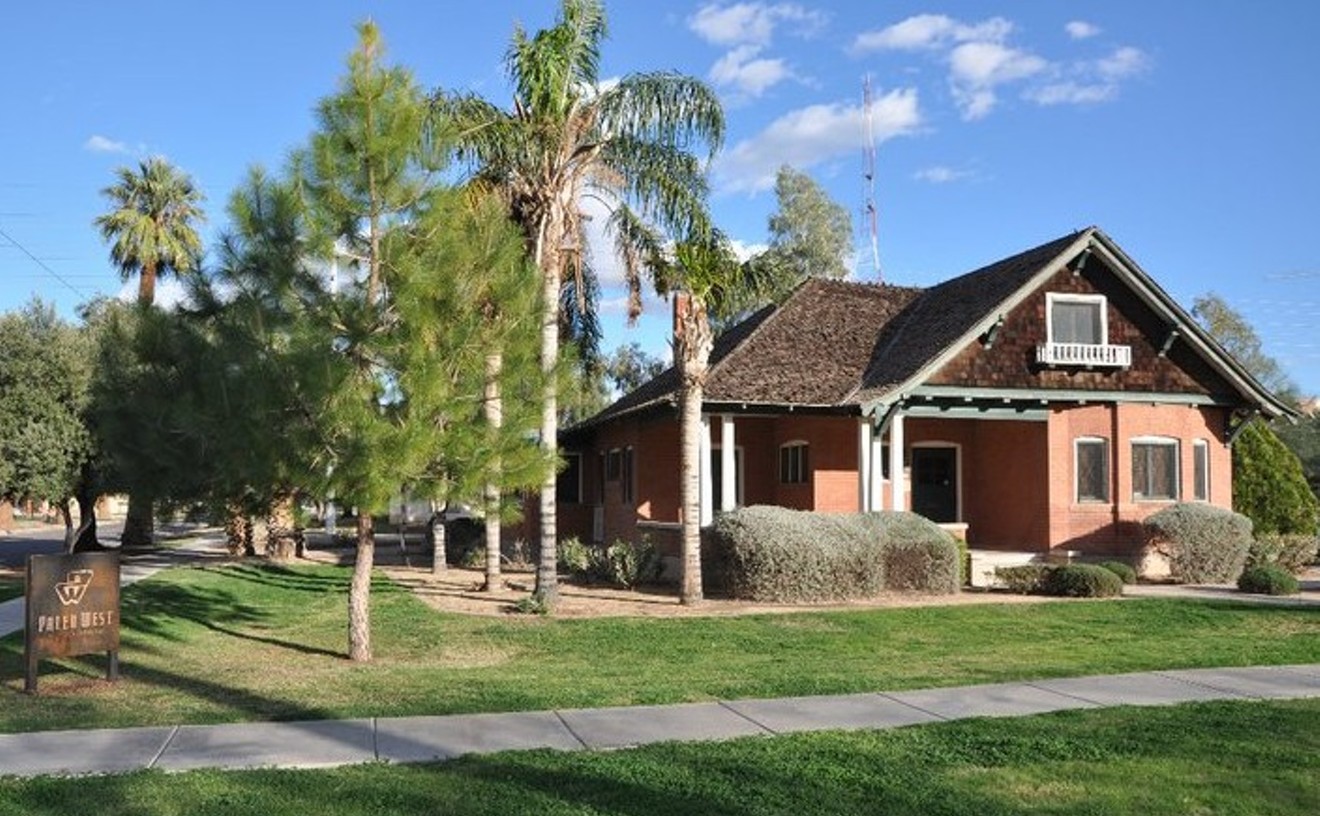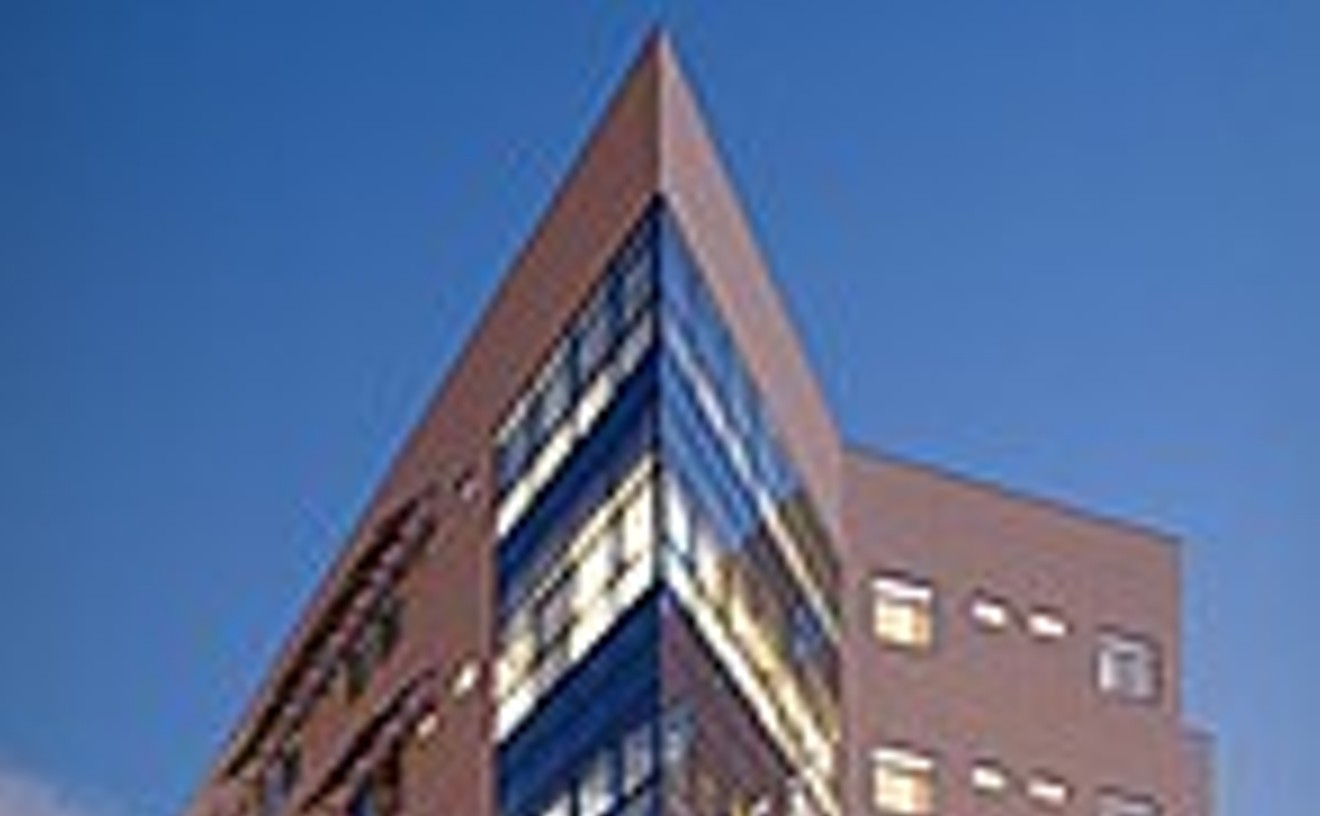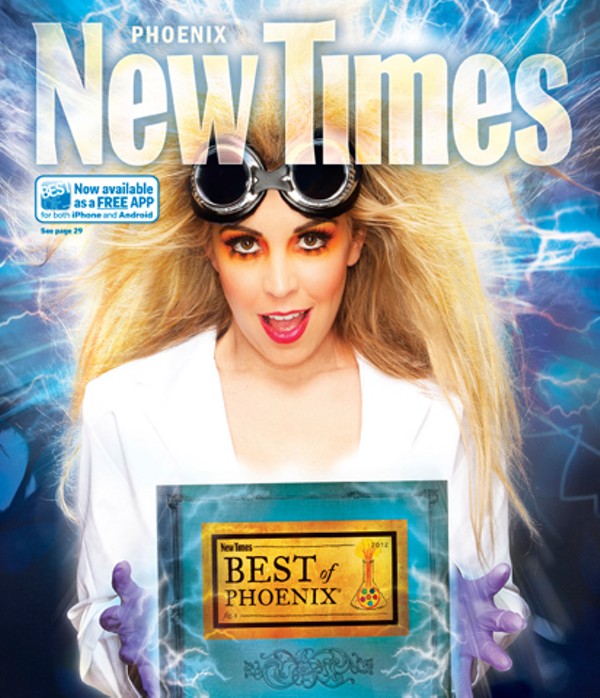The planets and extraterrestrial phenomena of outer space don't seem as far away anymore, thanks to the wonders of technology and the speed of the Internet. These days, wanna-be astronomers or those interested in seeing what's out there in the cosmos can easily log on to the Slooh Space Camera or similar online skywatching sites and watch both lunar and solar eclipses, as well as witness asteroids and other cosmic detritus zoom through our corner of the galaxy. But as convenient as such laptop cyber-stargazing can be, it isn't as interesting as attending one of the East Valley Astronomy Club's star parties. After all, all those twinkling stars are best seen in the great outdoors, which harks back to something Plato once stated many moons ago: "Astronomy compels the soul to look upwards and leads us from this world to another." And on a number of occasions each month, the 200-odd astronomy enthusiasts who make up the club, which has been scanning the skies since 1987, gaze into heavens using such heavy-duty telescopes as the Takahashi Epsilon-210 Astrograph at the Riparian Preserve at Water Ranch in Gilbert or other rural locations around the East Valley. As they aim their high-caliber optics toward the void, members of the public are invited to squint through the viewfinder at the cosmic bodies populating our own solar system or at far-flung nebulae. If only they'd let us bring out our boombox and blast Holst's The Planets during such sky-watching sessions.
Sci-Fi Author
Michael Stackpole
Author and Valley resident Michael Stackpole is a hero to nerds nationwide, likely because he's amassed a slew of achievements that some geeks only wish they could accomplish in their lifetimes. Over the past 35 years, he's designed critically acclaimed tabletop RPGs (Storm Haven, City Book I) and PC games (Star Trek: 25th Anniversary Edition), written popular novels in the BattleTech series, and appeared on the New York Times bestseller list multiple times. In the 1990s, George Lucas let him dabble in the Star Wars literary universe, allowing Stackpole to create some of the more iconic characters in the saga's history. Oh, and an asteroid was even named in his honor in 2008. Kinda makes your so-called feat of finally beating Diablo III seem a little weak by comparison, bro.
Best Mad Scientist
Lance Greathouse
Upon first glance, Lance Greathouse looks like a fairly straitlaced guy. He's got a wife, two kids, a suburban home, and a sedate day job as a dental laser technician. Brewing inside the 52-year-old's head, however, are visions of twisted creatures, lethal-looking contraptions, and frightening fire-breathing monsters. Mind you, Greathouse isn't insane but is instead an imaginative cat, and such conjurings are merely inspirations for the kooky contraptions he's been building in his backyard workshop for years. "I come out here when I'm not working and try to think of the wildest stuff I can create," he says. So far, the tinkerer, gearhead, and DIY diehard has constructed robotic scorpions, mechanized skeletons, and wheeled vehicles with fearsome appearances. (A few even starred on TV programs like BattleBots and Robot Wars.)
A majority of Greathouse's creations boast bad-ass propane-powered flamethrowers that emit conflagrations into the air, like the motorized armored three-wheeler dubbed "Lord Humongous." Greathouse's creations are a big hit out at Burning Man in Nevada, which he visits almost every year. He also brings out some of his more benign devices, like the "Ultimate Tailgating Station," a remote-controlled mobile grill and "party on wheels" that includes a barbecue, refrigerated beer tap, stereo system, and yet another flamethrower for roasting vegetables. It was seen on an episode of the National Geographic Channel's reality show Mad Scientists that he was featured on last winter. Viewers also got to glimpse some of the funky motorized wheelchairs Greathouse built for his late brother, who suffered from Parkinson's disease, including one patterned after Dr. Evil's chair from the Austin Powers flicks. "It's appropriate because some people seem to think I'm quite the mad scientist," he jokes. We don't know why they might come to that conclusion, Lance.Best Place to See Antique Medical Equipment
Phoenix Baptist Hospital Medical Museum
Without a doubt, modern medicine has come a long way since the long-forgotten era when doctors routinely gave bloodlettings or used such fantastically useless devices as electro-magnetic machines to treat ailments. For an illustration of this fact, look no further than the lobby of Phoenix Baptist Hospital, which features a unique and unusual museum of medical history. A pair of floor-to-ceiling glass cases located just inside the front door contains an expansive collection of antique doctor's tools, pharmaceutical and apothecary throwbacks, vintage medical ephemera, and other curiosities from a bygone age. Many shelves chronicle the various drugs, liniments, and tonics that physicians prescribed (many of which are in their original packaging), as well as old-timey pill bottles and numerous products containing opium. Curated by retired Valley gastroenterologist Robert Kravetz, who started accumulating the collection in 1971, the museum also includes many examples of medical practice like an ornate leech jar from Victorian England. If the prospect of having a vile blood-sucker attached to your flesh isn't scary enough, be sure to check out such cringe-inducing things as the large brass anal dilators (ouch) or the turn-of-the-century bone saw (double ouch). It's a great way to pass the time while you're waiting to see the doctor. Just be glad he won't be holding the business end of a leech in your direction.
- 2000 W. Bethany Home Rd., Phoenix, 85015 Map
- 602-249-0212
- www.abrazohealth.com/facilities/phoenix
Best Hope for Surviving a Nerve Gas Attack
Bioscavenger Project, Mor Lab at ASU Biodesign Institute

Today, if you are exposed to nerve gas — like the sarin used in the notorious 1995 Tokyo subway attacks — the best that anyone can do for you is administer a cocktail of drugs that may keep your heart beating long enough for the gas to wear off on its own. The drugs themselves are dangerous, and they do not stop any of the damage that nerve gas causes. But researchers at Mor Lab at ASU are working to change all that using genetically engineered plants and a blender that would look more at home at a Jamba Juice than in a laboratory.
It turns out that our bodies already possess an enzyme that not only deactivates the chemicals in nerve gas but also rips them apart at the molecular level. The problem is that we naturally produce this chemical, butyrylcholinesterase (BchE), at such low levels that it cannot help us in the event of a nerve gas attack. BchE is a complex molecule and nearly impossible to isolate or synthesize in any quantity. That is why researchers at Mor Lab are teaching tobacco plants how to grow the chemical for us. By splicing the ability to create BchE into plants, they can grow entire fields of this life-saving enzyme. Because they are plants, harvesting is easy; they just need to blend the whole plant and extract the BchE. Clearly, there is still much work to be done, but the initial results are extremely promising. Who thought tobacco could do such good?- 727 E. Tyler St., Tempe, 85281 Map
- biodesign.asu.edu/contact/locationmap
Best Use of Dirty Pool Water to Save Humanity
ASU's Laboratory for Algae Research and Biotechnology
Arizona has more pools per capita than anywhere in America. Given our weather, that's not really a shocker. What might be shocking is that some of the stuff that grows in your pool if you don't clean it might actually end up saving humanity.
The Laboratory for Algae Research and Biotechnology at ASU is conducting a whole raft of research centered on humble algae, the green crud that gathers in old pools and lakes. Some of the most exciting research is with algae-based biofuels. Current biofuels rely upon converting crops, primarily food crops like corn, into biofuels that we can use in our cars. While this has seen some success, there are real ethical problems with using food for fuel, as well as questions as to whether it actually is sustainable enough to justify biofuel production. That's where the algae comes in. Algae neatly steps around the ethical and practical problems surrounding biofuels. For obvious reasons, nobody is going to complain if a vast algae harvest is used to make fuel, nor do we have to sacrifice wide swaths of farmland just to make it. Researchers at ASU can grow a lot of algae in a very small area, and all they need is water, sunlight and some basic nutrients. The algae themselves produce oils which can be harvested and then refined into biofuel. Harvesting a "crop" of biofuels is as easy as emptying out their tank and giving it a good scrub.Best Place to Test Drive a Space Rover
Arizona -- NASA's Space Exploration Vehicle (SEV) and NASA's Desert Research and Technology Studies (D-RATS) team
While Arizona's frequent haboobs, blazing summers, and year-round dryness can be a challenge for residents, it's also the perfect weather for testing equipment we one day hope to send into space. NASA's Desert Research and Technology Studies (D-RATS) team descends on the Arizona desert every summer to put new space-exploration technology and principles through the torture of an Arizona summer. While they are in the desert, the D-RATS team perform a variety of simulated space missions.
Some of the most recent experiments have been with the unambiguously named Space Exploration Vehicle (SEV). The SEV is like the wild space-going spawn of a pickup truck and a camper trailer, suitable for missions to Mars or to the surface of an asteroid. It's designed to be able to travel thousands of miles over rocky terrain with little or no maintenance. Astronauts can operate the vehicle in a "shirtsleeve" environment but quickly transfer into their spacesuits for a walk outside. While they are in the desert, the D-RATS team perform a variety of simulated space missions. Driving the SEV is unlike anything else out there because it has the ability to turn its multitude of wheels in virtually any direction and even use hydraulics to "crab walk" sideways across very difficult terrain. Granted, for as cool as it sounds, the SEV isn't for those with a need for speed. It clocks a top speed of only 10 kilometers per hour.Best Use of a Camera on Mars
Thermal Emission Imaging System (THEMIS) at Mars Space Flight Facility
Researchers at ASU helped throw the Mars Odyssey orbiter into space way back in 2001. One of the major pieces of equipment they are responsible for was the THEMIS (Thermal Emission Imaging System). The THEMIS is much more than a super-expensive digital camera. It's a super-expensive digital camera that can take pictures of the infrared spectrum.
Looking into the infrared means that the Mars Odyssey probe is able to see things from orbit that a regular camera could not. It can spot things like the residual heat from deep geothermal systems or compare types of rocks just by how they retain or reflect heat from the sun. Superficially, this just means it sends back a bunch of black-and-white photos, but its real value becomes clear when you try to do something a little crazy. Like land a nuclear-powered Cooper Mini on the surface of Mars using a rocket skycrane. Before the Curiosity Mars rover even neared the Red Planet, THEMIS sat in high orbit scoping out landing sites for the probe. From those pictures, scientists were able to help pick out an ideal landing site along the Gale Crater for the rover. The data they collected allowed them to look even more closely at the surface, picking a spot that appeared to be free of massive rocks. And, given the success of Curiosity, it looks like THEMIS chose well.Best Local Indiana Jones
Todd Bostwick, PaleoWest Solutions in Archaeology

For those who say Arizona has no history, Todd Bostwick would like a word with you. The senior research archeologist at PaleoWest Archaeology and executive director of the Verde Valley Archaeology Center in Camp Verde, Bostwick has been working in the field for more than 40 years. So he's got some history — including multiple degrees and a résumé that is, no joke, 12 pages long. How does a guy acquire such an extensive portfolio in a field that would drive the not-so-meticulous insane? Well, unlike most of us, Bostwick has had a passion for his current field since childhood. Long before the days of Indiana Jones, Bostwick was digging up century-old toys he found in the yard of his parents' Nevada home.
Lucky for Phoenix, Bostwick enjoys sharing his archeological finds (his specialties are rock art and ancient astronomy) with others, even going so far as to do house calls (assuming you've found ancient treasures in your backyard). Alongside his more technical published works, Bostwick has published informational books that are more conducive to the everyday amateur scientist, including Landscape of the Spirits: Hohokam Rock Art at South Mountain Park and Beneath the Runways: Archaeology of Sky Harbor International Airport.And though he recently retired from the city of Phoenix after serving as city archaeologist for more than 20 years, Bostwick admits he'll never truly stop digging. See a slideshow here.- 649 N. 3rd Ave., Phoenix, 85003 Map
- 602-261-7253
- www.paleowest.com
Best Brain Surgeon
Dr. Robert F. Spetzler at Barrow Neurological Institute

We hope to never suffer any cerebral damage in our lifetime, but we do know the right guy for the job, if the worst happens. (Come to think of it, we should probably write down his name and tape it to the fridge in case of said damage.) Dr. Robert Spetzler is director of the Barrow Neurological Institute at St. Joseph's Hospital, where he and his team lead the nation in the number of brain surgeries performed and brain surgeons trained. A celebrity in the medical world, Dr. Spetzler specializes in aneurysms, skull base tumors, and other brain malformations and has operated on nearly 6,000 brain aneurysms in his career, which is more than anyone else in the world.
In 1986, Dr. Spetzler took on the role of director at Barrow and banded together a group of skilled neurosurgeons to form Barrow Neurological Associates. He helped create a residency program that medical students from across the country aspire to make, at a hospital that patients all over the globe seek access to. He also was a key player in developing a life-saving surgical technique (the cardiac standstill) for safely removing aneurysms, as well as new surgical tools, including the 3D microscope. The man's busy. So while it's nice to know he's there if we need him, if you foresee yourself engaging in any act of physical stupidity, we suggest you take his advice and "helmet your head." See a slideshow here.- 350 W. Thomas Rd., Phoenix, 85013 Map
- 602-406-6281
- www.barrow.org





